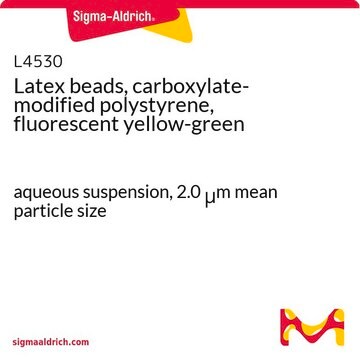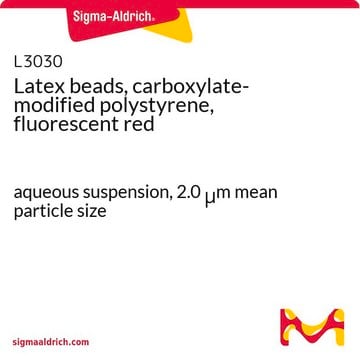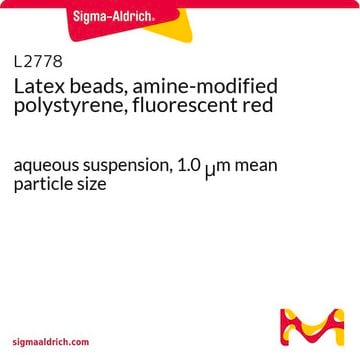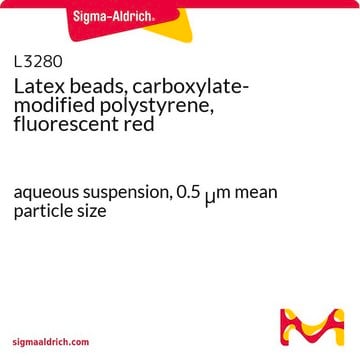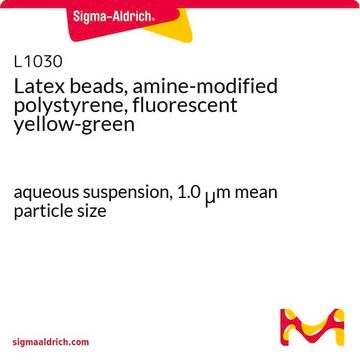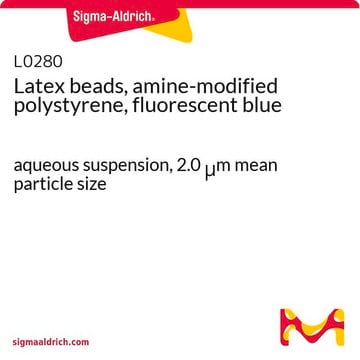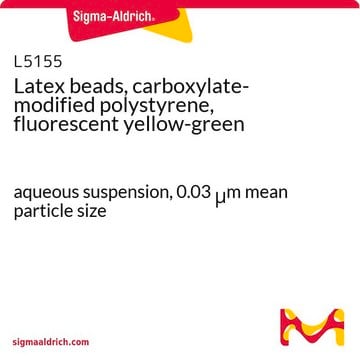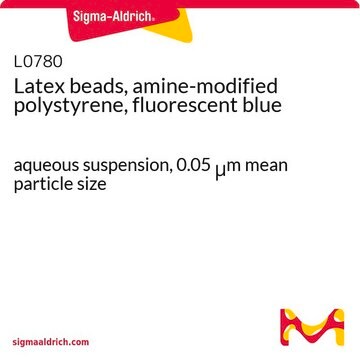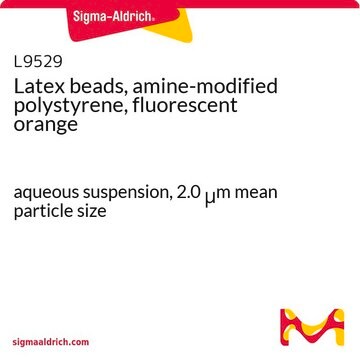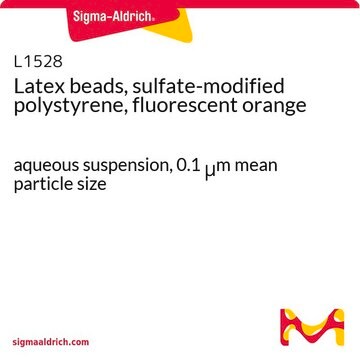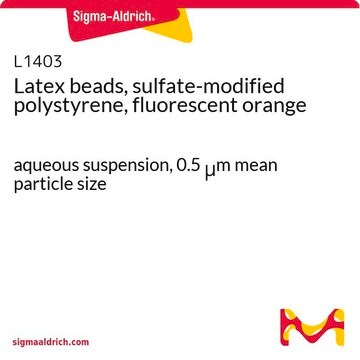The concentration of the Latex Beads is approximately 4.75x10^10 beads/mL.
L4655
Latex beads, carboxylate-modified polystyrene, fluorescent yellow-green
aqueous suspension, 1.0 μm mean particle size
Synonym(s):
Fluorescent Latex Beads
Select a Size
About This Item
Recommended Products
form
aqueous suspension
Quality Level
composition
Solids, 2.5%
technique(s)
cell based assay: suitable
mean particle size
1.0 μm
fluorescence
λex ~470 nm; λem ~505 nm
suitability
suitable for immunoassay
application(s)
cell analysis
Looking for similar products? Visit Product Comparison Guide
Application
- in epidermal growth factor conjugate preparation for indirect immunofluorescence imaging studies[1]
- for culturing mouse bronchoalveolar macrophages and human monocyte-derived macrophages prior to phagocytosis imaging studies[2]
- in coadministration with Salmonella expressed green fluorescent protein (GFP) for confocal microscopy studies and in biofluorescence imaging[3]
Storage Class Code
10 - Combustible liquids
WGK
WGK 3
Flash Point(F)
Not applicable
Flash Point(C)
Not applicable
Choose from one of the most recent versions:
Already Own This Product?
Find documentation for the products that you have recently purchased in the Document Library.
Customers Also Viewed
-
What is the concentration of product L4655?
1 answer-
Helpful?
-
-
What are the ingredients of the solution in which the plastic is diluted? Can I dilute it in PBS?
1 answer-
This product is prepared in water containing a prioprietary anionic surfactant and >0.1% Sodium Azide. Phosphate Buffered Saline is a suitable diluent.
Helpful?
-
-
Are there latex beads recommended for phagocytosis, and if so, what size is recommended?
1 answer-
There is no performance testing of latex beads for phagocytosis. Information found indicates that internally, there are no specific protocols or recommendations for a phagocytosis method using the listed latex beads. However, references to literature where the products have been used in research are provided. The maximum excitation and emission for one of the latex bead products, L3280, are also mentioned. Additionally, three products (catalog numbers 59769, 43302, and 89904) were found on the company website, with variations in bead size and fluorescence. For more details, you may refer to the provided links and Knowledge Article 000007596.
Helpful?
-
-
What are the differences between carboxylate-modified polystyrene and amine-modified polystyrene Latex beads, and which type of beads is suitable for phagocytosis applications?
1 answer-
When selecting beads for phagocytosis assays, there are three key parameters to consider: the size of the bead, the color of the bead (dyed or undyed), and the modification of the bead (carboxylate, amine, or sulfate modified).
Beads chosen for phagocytosis experiments typically range from approximately 0.5 to 3 micrometers in size. A 1:250 dilution of the beads into the culture medium is commonly used for phagocytosis experiments. Latex Beads, 2 um (Product No. L0905), can be utilized for phagocytosis assays, as macrophages can phagocytose particles larger than 2 um.
Fluorescent latex beads are available with different fluorescent dyes incorporated into the beads. The yellow-green beads are commonly used for phagocytosis studies and are compatible with most flow cytometers and fluorescent microscopes.
For phagocytosis applications, the choice of bead modification (carboxylate vs. amine) depends on the specific assay being conducted. Carboxylate-modified beads, with a negative charge, mimic the uptake of apoptotic cells, while amine-modified beads, with a positive charge, are used to mimic the uptake of opsonized cells.
Helpful?
-
-
What is the recommended storage temperature?
1 answer-
This product may be stored at room temperature. For products with no specified storage temperature given on the label or product page, ambient storage may be assumed. Products that require controlled temperature storage, such as refrigeration or freezer conditions, storage temperatures are published on the product label, Certificate of Analysis, the Safety Data Sheet (SDS).
Helpful?
-
Active Filters
Our team of scientists has experience in all areas of research including Life Science, Material Science, Chemical Synthesis, Chromatography, Analytical and many others.
Contact Technical Service